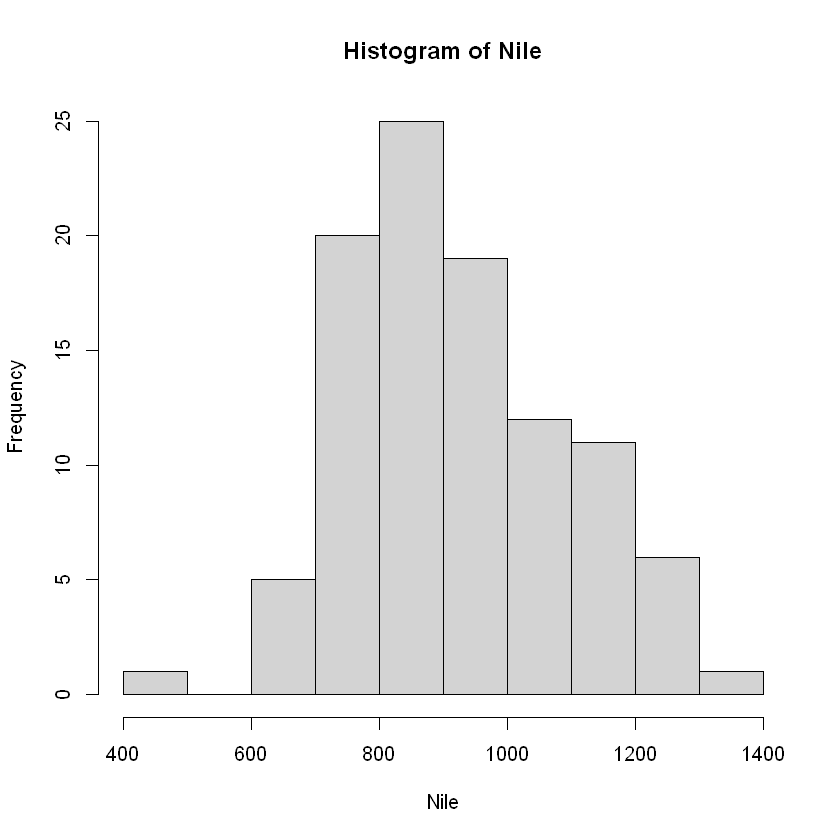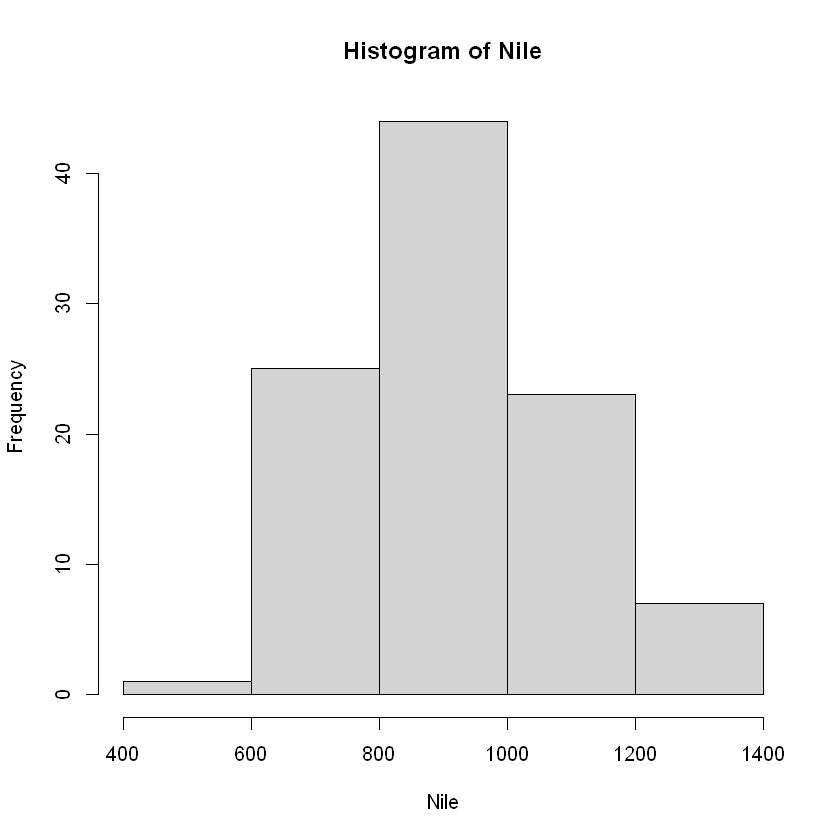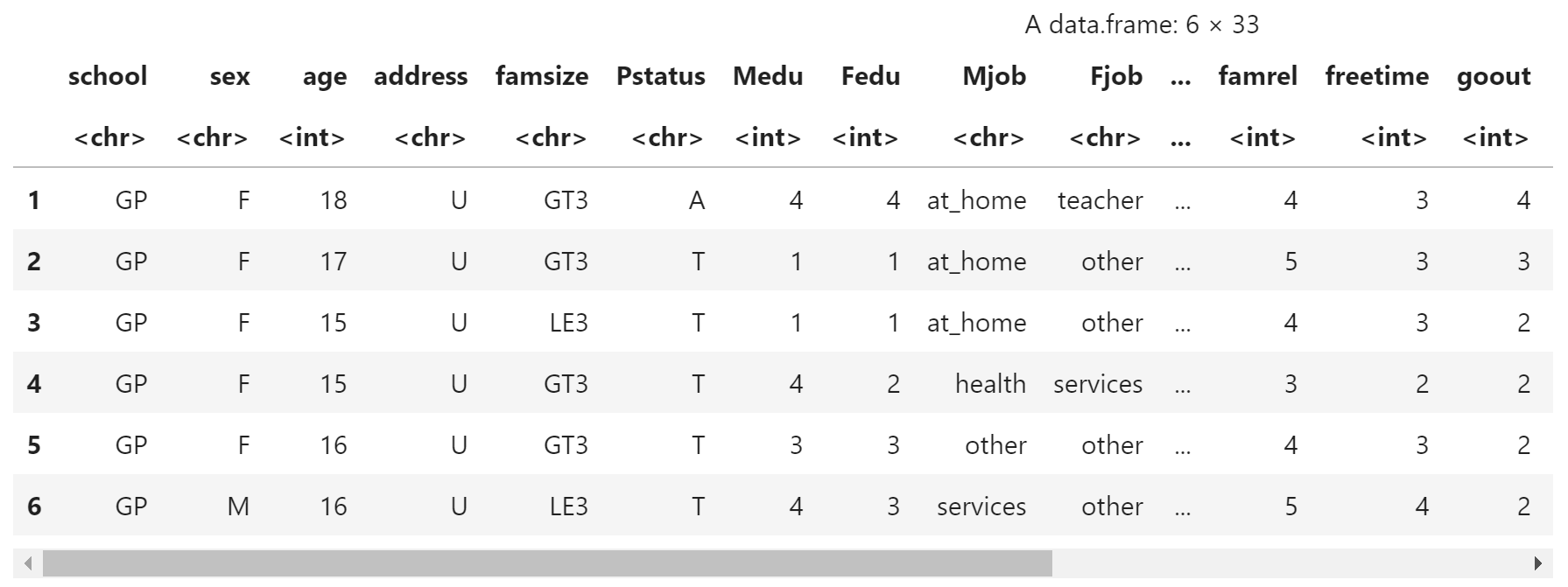学习 R 语言:快速开始
本文内容来自《R 语言编程艺术》(The Art of R Programming),有部分修改
运行R
交互模式
使用命令行运行 R.exe (linux 中运行 R)
本文示例均在 Jupyter Lab 中运行 R 环境
注:在 Jupyter Notebook 中,只有使用
下面代码为了展示输出结果均为向量,均使用
print(mean(abs(rnorm(100))))[1] 0.7482577
print(rnorm(10)) [1] 0.03721293 -0.20435474 -0.19896266 -0.81638471 2.38975757 -0.13099913
[7] -1.69019026 1.04377265 0.83753176 -1.41777840
批处理模式
pdf("xh.pdf")
hist(rnorm(100))
dev.off()R.exe CMD BATCH z.R
R 会话
注:从本节开始,代码中省略 print 函数调用,与命令行交互模式保持一致
向量
R 语言中最基本的数据类型是向量
<- 是 R 语言的标准赋值运算符
使用 c 创建向量,c 表示连接 (concatenate)
x <- c(1, 2, 4)
x[1] 1 2 4
c 中也可以使用向量,注意这种方式是将向量展开,而不是生成嵌套的向量
q <- c(x, x, 8)
q[1] 1 2 4 1 2 4 8
注:对比 Python 列表的 append 和 expend 方法
访问向量中的元素
注意:R 语言中的索引从 1 开始!
与 C 语言和 Python 不同
x[3][1] 4
提取子集
注意:R 语言中的范围包含最后一个元素,即使用闭区间
[a, b]!而 Python 中不包含最后一个元素,即使用左闭右开区间
[a, b)
x[2:3][1] 2 4
求统计值
求均值和标准差
mean(x)[1] 2.333333
sd(x)[1] 1.527525
将统计值赋值给变量
R 语言中的注释也以 # 开头
y <- mean(x)
y # print out y[1] 2.333333
内置数据集
使用 data() 函数返回内置的数据集
data()
以尼罗河水流量数据集 Nile 为例,计算统计值
mean(Nile)[1] 919.35
sd(Nile)[1] 169.2275
画直方图
hist(Nile)
hist 提供各类参数来控制图形
例如,使用 breaks 函数指定分组数
hist(Nile, breaks=5)
调用 q() 函数可以退出 R 命令行交互模式。
函数入门
与 Python 类似,函数同样是 R 语言编程的核心
下面的函数统计向量中奇数的个数
其中 %% 是求余操作符(Python 中是 %)
oddcount <- function(x) {
k <- 0
for (n in x) {
if (n %% 2 == 1) k <- k + 1
}
return(k)
}测试下上面的函数
oddcount(c(1, 3, 5))[1] 3
oddcount(c(1, 2, 3, 7, 9))[1] 4
变量的作用域
k 和 n 都是函数的局部变量。
参数 x 是形式参数 (formal argument),R 语言中的形式参数是 局部变量。
函数内对参数的修改不会影响函数外的值。
注:这意味着函数调用会发生数据复制,需要考虑耗时问题。不知道是否有指针形式的参数传递方式?
函数可以访问全局变量
f <- function(x) return(x+y)
y <- 3
f(5)[1] 7.333333
注:上例可以看到 R 语言对函数变量的处理与 Python 类似,在实际执行时确定变量
函数内部给全局变量赋值需要使用超级赋值运算符 (superassignment operator) <<-,后续会介绍
默认函数
R 语言也支持默认参数
g <- function(x, y=2, z=T) {
return(z)
}
g(12, z=FALSE)[1] FALSE
T 和 FALSE 都是布尔类型
重要数据结构
向量,R 语言中的战斗机
向量元素必须属于同一种模式 (mode),或者说是数据类型
注意:R 语言中没有标量,单个数值是一元向量
x <- 8
x[1] 8
输出的 [1] 表示这行的开头是向量的第一个元素,也就意味着单个数被 R 语言当成长度为 1 的向量
字符串
字符串实际上是字符模式的单元素向量
先看数值模式的向量
x <- c(5, 12, 13)
x[1] 5 12 13
length(x)
[1] 3
mode(x)[1] "numeric"
创建字符串,即一元字符串向量
y <- "abc"
y[1] "abc"
length(y)[1] 1
mode(y)[1] "numeric"
创建多元素字符串向量
z <- c("abc", "29 88")
length(z)[1] 2
mode(z)[1] "character"
字符串操作函数举例
u <- paste("abc", "de", "f")
print(u)[1] "abc de f"
v <- strsplit(u, " ")
print(v)[[1]]
[1] "abc" "de" "f"
矩阵
矩阵是向量,附加两个属性:行数和列数
使用 rbind() 将多个向量逐行结合成一个矩阵
m <- rbind(
c(1, 4),
c(2, 2)
)
print(m) [,1] [,2]
[1,] 1 4
[2,] 2 2
%*% 计算矩阵乘法
print(m %*% c(1, 1)) [,1]
[1,] 5
[2,] 4
矩阵使用双下标作为索引,与向量一样,索引从 1 开始
类似 Python 中 numpy 数组的索引方法
m[1, 2][1] 4
m[2, 2][1] 2
提取子矩阵
注:numpy 数组也提供类似的功能,不过 R 语言更简洁
print(m[1, ]) # 提取第 1 行[1] 1 4
print(m[, 2]) # 提取第 2 列[1] 4 2
列表
值的容器,各个元素可以属于不同的类型,使用名称来访问各元素。
注:类似 Python 中的字典 (dict)
x <- list(u=2, v="abc")
print(x)$u
[1] 2
$v
[1] "abc"
访问 u 组件
print(x$u)[1] 2
列表常用于函数返回多个结果
上面调用 hist(Nile) 生成直方图,该函数也有返回值
hn <- hist(Nile)查看返回的内容,返回值描述了直方图的特征
hn$breaks
[1] 400 500 600 700 800 900 1000 1100 1200 1300 1400
$counts
[1] 1 0 5 20 25 19 12 11 6 1
$density
[1] 0.0001 0.0000 0.0005 0.0020 0.0025 0.0019 0.0012 0.0011 0.0006 0.0001
$mids
[1] 450 550 650 750 850 950 1050 1150 1250 1350
$xname
[1] "Nile"
$equidist
[1] TRUE
attr(,"class")
[1] "histogram"
也可以使用 str 函数以更简洁的方式打印列表,str 代表 structure
str(hn)List of 6
$ breaks : int [1:11] 400 500 600 700 800 900 1000 1100 1200 1300 ...
$ counts : int [1:10] 1 0 5 20 25 19 12 11 6 1
$ density : num [1:10] 0.0001 0 0.0005 0.002 0.0025 0.0019 0.0012 0.0011 0.0006 0.0001
$ mids : num [1:10] 450 550 650 750 850 950 1050 1150 1250 1350
$ xname : chr "Nile"
$ equidist: logi TRUE
- attr(*, "class")= chr "histogram"
数据框
Python 中大名鼎鼎的 pandas 库中核心概念
DataFrame即来自 R 语言。
数据框可以当成是不同类型数据组成的“矩阵”。
数据框实际上的列表,只不过列表的每个组件是由“矩阵”数据的一列构成的。
d <- data.frame(list(
kids=c("Jack", "Jill"),
ages=c(12, 10)
))
print(d) kids ages
1 Jack 12
2 Jill 10
访问数据框的某列
print(d$ages)[1] 12 10
类
简单介绍 S3 类的使用。
hist() 的返回值是一个列表,但还有一个属性 (attribute),指定类表的类,这里是 histogram 类。
对 S3 类可以用 summary() 泛型函数查看摘要信息。
summary(hn) Length Class Mode
breaks 11 -none- numeric
counts 10 -none- numeric
density 10 -none- numeric
mids 10 -none- numeric
xname 1 -none- character
equidist 1 -none- logical
扩展案例:考试成绩的回归分析
数据下载自 https://www.kaggle.com/dipam7/student-grade-prediction
原始数据来自 https://archive.ics.uci.edu/ml/datasets/student+performance
使用 read.csv 读取 CSV 文件
score <- read.csv(file="student-mat.csv")返回的结果是数据框类型
print(class(score))[1] "data.frame"
使用 head 查看数据的前几行,因为 CSV 文件包含表头,所以数据列均已被命名
head(score)
使用期中考试成绩 (G2) 预测期末考试成绩 (G3)
lm 函数实现线性拟合
lma <- lm(score$G3 ~ score$G2)lma 是 lm 类的一个实例。使用 attributes() 函数列出所有组件
print(attributes(lma))$names
[1] "coefficients" "residuals" "effects" "rank"
[5] "fitted.values" "assign" "qr" "df.residual"
[9] "xlevels" "call" "terms" "model"
$class
[1] "lm"
打印详细信息
str(lma)List of 12
$ coefficients : Named num [1:2] -1.39 1.1
..- attr(*, "names")= chr [1:2] "(Intercept)" "score$G2"
$ residuals : Named num [1:395] 0.78 1.882 2.576 0.963 0.372 ...
..- attr(*, "names")= chr [1:395] "1" "2" "3" "4" ...
$ effects : Named num [1:395] -206.998 82.288 2.481 1.007 0.323 ...
..- attr(*, "names")= chr [1:395] "(Intercept)" "score$G2" "" "" ...
$ rank : int 2
$ fitted.values: Named num [1:395] 5.22 4.12 7.42 14.04 9.63 ...
..- attr(*, "names")= chr [1:395] "1" "2" "3" "4" ...
$ assign : int [1:2] 0 1
$ qr :List of 5
..$ qr : num [1:395, 1:2] -19.8746 0.0503 0.0503 0.0503 0.0503 ...
.. ..- attr(*, "dimnames")=List of 2
.. .. ..$ : chr [1:395] "1" "2" "3" "4" ...
.. .. ..$ : chr [1:2] "(Intercept)" "score$G2"
.. ..- attr(*, "assign")= int [1:2] 0 1
..$ qraux: num [1:2] 1.05 1.07
..$ pivot: int [1:2] 1 2
..$ tol : num 1e-07
..$ rank : int 2
..- attr(*, "class")= chr "qr"
$ df.residual : int 393
$ xlevels : Named list()
$ call : language lm(formula = score$G3 ~ score$G2)
$ terms :Classes 'terms', 'formula' language score$G3 ~ score$G2
.. ..- attr(*, "variables")= language list(score$G3, score$G2)
.. ..- attr(*, "factors")= int [1:2, 1] 0 1
.. .. ..- attr(*, "dimnames")=List of 2
.. .. .. ..$ : chr [1:2] "score$G3" "score$G2"
.. .. .. ..$ : chr "score$G2"
.. ..- attr(*, "term.labels")= chr "score$G2"
.. ..- attr(*, "order")= int 1
.. ..- attr(*, "intercept")= int 1
.. ..- attr(*, "response")= int 1
.. ..- attr(*, ".Environment")=<environment: R_GlobalEnv>
.. ..- attr(*, "predvars")= language list(score$G3, score$G2)
.. ..- attr(*, "dataClasses")= Named chr [1:2] "numeric" "numeric"
.. .. ..- attr(*, "names")= chr [1:2] "score$G3" "score$G2"
$ model :'data.frame': 395 obs. of 2 variables:
..$ score$G3: int [1:395] 6 6 10 15 10 15 11 6 19 15 ...
..$ score$G2: int [1:395] 6 5 8 14 10 15 12 5 18 15 ...
..- attr(*, "terms")=Classes 'terms', 'formula' language score$G3 ~ score$G2
.. .. ..- attr(*, "variables")= language list(score$G3, score$G2)
.. .. ..- attr(*, "factors")= int [1:2, 1] 0 1
.. .. .. ..- attr(*, "dimnames")=List of 2
.. .. .. .. ..$ : chr [1:2] "score$G3" "score$G2"
.. .. .. .. ..$ : chr "score$G2"
.. .. ..- attr(*, "term.labels")= chr "score$G2"
.. .. ..- attr(*, "order")= int 1
.. .. ..- attr(*, "intercept")= int 1
.. .. ..- attr(*, "response")= int 1
.. .. ..- attr(*, ".Environment")=<environment: R_GlobalEnv>
.. .. ..- attr(*, "predvars")= language list(score$G3, score$G2)
.. .. ..- attr(*, "dataClasses")= Named chr [1:2] "numeric" "numeric"
.. .. .. ..- attr(*, "names")= chr [1:2] "score$G3" "score$G2"
- attr(*, "class")= chr "lm"
组件名可以使用缩写,只要与其他名称不发生混淆即可。
注:作为刚接触 R 语言的新人,笔者强烈不推荐使用缩写。太灵活会带来很多问题
当前代码自动补全已成为编辑器的标配,没有必要再使用缩写
例如,获取线性拟合的系数
print(lma$coef)(Intercept) score$G2
-1.392758 1.102112
直接打印 lma 展示的信息不多,实际上是调用 print.lm() 函数
print(lma)Call:
lm(formula = score$G3 ~ score$G2)
Coefficients:
(Intercept) score$G2
-1.393 1.102
使用 summary() 可以展示更多信息,实际上是调用 summary.lm() 函数
summary(lma)Call:
lm(formula = score$G3 ~ score$G2)
Residuals:
Min 1Q Median 3Q Max
-9.6284 -0.3326 0.2695 1.0653 3.5759
Coefficients:
Estimate Std. Error t value Pr(>|t|)
(Intercept) -1.39276 0.29694 -4.69 3.77e-06 ***
score$G2 1.10211 0.02615 42.14 < 2e-16 ***
---
Signif. codes: 0 '***' 0.001 '**' 0.01 '*' 0.05 '.' 0.1 ' ' 1
Residual standard error: 1.953 on 393 degrees of freedom
Multiple R-squared: 0.8188, Adjusted R-squared: 0.8183
F-statistic: 1776 on 1 and 393 DF, p-value: < 2.2e-16
使用 G1 和 G2 成绩预测 G3 成绩
下面的 + 仅仅是预测变量 (predictor variable) 的分隔符
lmb <- lm(score$G3 ~ score$G1 + score$G2)
summary(lmb)Call:
lm(formula = score$G3 ~ score$G1 + score$G2)
Residuals:
Min 1Q Median 3Q Max
-9.5713 -0.3888 0.2885 0.9725 3.7089
Coefficients:
Estimate Std. Error t value Pr(>|t|)
(Intercept) -1.83001 0.33531 -5.458 8.57e-08 ***
score$G1 0.15327 0.05618 2.728 0.00665 **
score$G2 0.98687 0.04957 19.909 < 2e-16 ***
---
Signif. codes: 0 '***' 0.001 '**' 0.01 '*' 0.05 '.' 0.1 ' ' 1
Residual standard error: 1.937 on 392 degrees of freedom
Multiple R-squared: 0.8222, Adjusted R-squared: 0.8213
F-statistic: 906.1 on 2 and 392 DF, p-value: < 2.2e-16
启动和关闭 R
R 会话启动时会执行保存在 .Rprofile 中的命令。
比如可以添加额外的库路径
.libPaths("/home/nm/R")
获取当前路径
current <- getwd()
print(current)[1] "D:/windroc/project/study/r/tarp/chap01"
设置当前路径
setwd("D:/")
getwd()
setwd(current)
getwd()'D:/'
'D:/windroc/project/study/r/tarp/chap01'
获取帮助
help() 函数
help(seq)? 可以快速调用 help() 函数
?seq使用 help 时,特殊字符和一些保留字符必须用引号括起来
?"<"
?"for"example() 函数
example() 函数会运行示例代码
example(seq)对于绘图函数,example 会提供图形化展示
example(persp)搜索
如果不太清楚想要查找什么,可以使用 help.search() 函数进行查找
help.search("multivariate normal")?? 是 help.search 快捷方法
??"multivariate normal"其他主题的帮助
?mvrnorm获取整个包的信息
help(package=MASS)获得一般主题的帮助
?files批处理模式的帮助
R CMD command --help
例如
R CMD install --help
互联网资源
Just Google it
